Minimum wage has been a major conversation among politicians, activists, employers, and employees in recent years. Millions of Americans live paycheck to paycheck or struggle to make ends meet, working multiple jobs to make up for the fact that the federal minimum wage has not kept up with the rate of inflation. Today, federal minimum wage is $7.25—it has not increased since 2009. However, it hasn’t always been difficult to live off of a minimum wage job.
In honor of Labor Day yesterday, we will use our new Labor and Employment: The American Worker database, which is currently available for a 10% discount, to explore the history of federal and state-level minimum wage in the United States, diving into the laws and court cases that have gotten us to where we are today.
Stirrings of Discontent
One of the first demands for a minimum wage came during a strike among silk workers in France in 1831. Though it wasn’t successful, the strike brought attention to the idea of a minimum wage standard. In 1894, New Zealand became the first country to enact a federal minimum wage with the Industrial Conciliation and Arbitration Act.[1]Edgar S.; Guild Furniss, Lawrence R. Labor Problems: A Book of Materials for Their Study (1925). This book can be found in HeinOnline’s Legal Classics and Labor and Employment: The American Worker databases. Australia and the United Kingdom followed suit in 1896 and 1909, respectively.
In America, the idea of a federal minimum wage gained traction when Samuel Gompers, the founding president of the American Federation of Labor, published an article in 1898 called “A Minimum Living Wage,” which called for a standard base hourly wage that workers could live upon. Initial calls for a minimum wage were in response to sweatshop conditions. The establishment of consumer leagues, such as the Consumer’s League of the City of New York, led to boycotts of products made under sweatshop conditions and the establishment of the National Consumer League.[2]By the Sweat and Toil of Children: A Report to the Committees on Appropriations, United States Congress (1997). This document can be found in HeinOnline’s Legal Classics and Labor and Employment: The American Worker databases.
Massachusetts became the first state to pass minimum wage legislation,[3]‘Massachusetts – General Court, Acts and Resolves 771. This Law can be found in HeinOnline’s Session Laws Library. as a result of pressure from advocacy groups such as the Women’s Trade Union League of Massachusetts, as well as the Lawrence textile strike.[4]Michael Schuman, History of Child Labor in the United States – Part 2: The Reform Movement, 140 MONTHLY LAB. REV. 1 (2017). This article can be found in HeinOnline’s Law Journal Library and Labor and Employment: The … Continue reading The law passed in 1912 and only applied to women and children. Other states began passing their own minimum wage laws, and by 1923, thanks to efforts from organized labor and the National Consumers League, 15 states and Washington, D.C. had passed their own minimum wage laws.
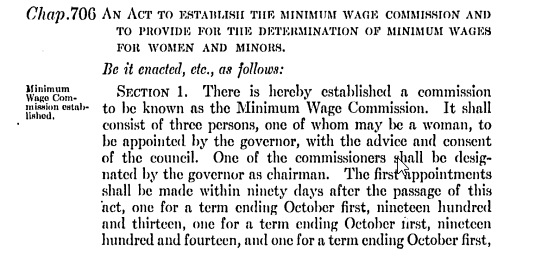
The Lochner Era
The Supreme Court from 1897 to 1937 was quick to strike down laws that regulated working conditions, wages, or hours. The name “Lochner era” is based on the case Lochner v. New York[5]Lochner v. New York, 198 U.S. 45, 76 (1905). This case can be found in HeinOnline’s U.S. Supreme Court Library and Labor and Employment: The American Worker databases. (1905), in which the Supreme Court deemed a New York law that capped bakers’ workweeks to 60 hours as unconstitutional. Similarly, the Court struck down several laws attempting to establish a minimum wage. The first federal laws to pass in America to establish a minimum wage were primarily focused on women and children, but these were all struck down by the Supreme Court. For example, Adkins v. Children’s Hospital[6]Adkins et al., Constituting the Minimum Wage Board of the District of Columbia, v. Children’s Hospital of the District of Columbia – Same v. Lyons, 261 U.S. 525, 570 (1923). This case can be found in HeinOnline’s U.S. Supreme Court … Continue reading determined that Washington, D.C.’s minimum wage law designed to protect women workers was unconstitutional.
The first federal minimum wage law in America was passed by President Franklin D. Roosevelt—as part of the New Deal, he passed the National Industrial Recovery Act[7]To encourage national industrial recovery, to foster fair competition, and to provide for the construction of certain useful public works, and for other purposes., Public Law 73-67 / Chapter 90, 73 Congress. 48 Stat. 195 (1928-1934) (1933). This act … Continue reading of 1933. However, the law was struck down by the Supreme Court in the case Schechter Poultry Corp. v. United States.[8]A. L. A. Schechter Poultry Corp. et al. v. United States, 295 U.S. 495, 554 (1935). This case can be found in HeinOnline’s U.S. Supreme Court Library and Labor and Employment: The American Worker databases.
The end of the Lochner era came in 1937 when, in the case West Coast Hotel Co. v. Parrish,[9]West Coast Hotel Co. v. Parrish et al, 300 U.S. 379, 413 (1937). This case can be found in HeinOnline’s U.S. Supreme Court Library and Labor and Employment: The American Worker databases. the Supreme Court upheld minimum wage legislation in Washington State, effectively overturning the Adkins decision.
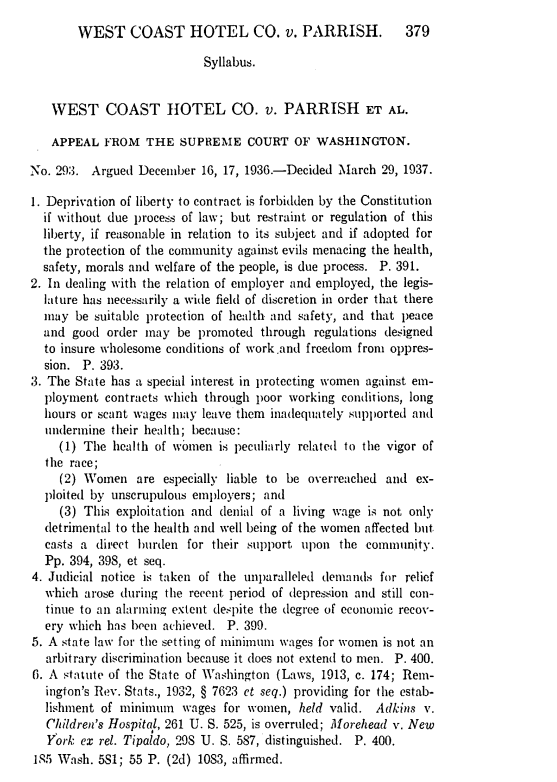
Federal Minimum Wage Laws
The Fair Labor Standards Act of 1938[10]To provide for the establishment of fair labor standards in employments in and affecting interstate commerce, and for other purposes., Public Law 75-718 / Chapter 676, 75 Congress. 52 Stat. 1060 (1938). This act can be found in HeinOnline’s … Continue reading set the federal minimum wage at $0.25 an hour (equivalent to the buying power of $5.38 today)—the law was upheld in United States v. Darby Lumber Co.[11]United States v. Darby, 312 U.S. 100, 125 (1941). This case can be found in HeinOnline’s U.S. Supreme Court Library and Labor and Employment: The American Worker databases. in 1941. Initially, the law only applied to employees working in interstate commerce or producing goods for interstate commerce. However, the law was amended in both 1961[12]To amend the Fair Labor Standards Act of 1938, as amended, to provide coverage for employees of large enterprises engaged in retail trade or service and of other employers engaged in commerce or in the production of goods for commerce, to increase … Continue reading and 1966[13]To amend the Fair Labor Standards Act of 1938 to extend its protection to additional employees, to raise the minimum wage, and for other purposes., Public Law 89-601, 89 Congress. 80 Stat. 830 (1966). This act can be found in HeinOnline’s U.S. … Continue reading to apply to employees in additional industries, while a clause passed in 1990[14]To amend the Fair Labor Standards Act of 1938 to increase the minimum wage, and for other purposes., Public Law 101-157, 101 Congress. 103 Stat. 938 (1989). This act can be found in HeinOnline’s U.S. Statutes at Large database. made the federal minimum wage applicable to most employees. Additionally, in 1963, President John F. Kennedy passed the Equal Pay Act,[15]To prohibit discrimination on account of sex in the payment of wages by employers engaged in commerce or in the production of goods for commerce., Public Law 88-38, 88 Congress. 77 Stat. 56 (1963). This act can be found in HeinOnline’s U.S. … Continue reading an amendment to the Fair Labor Standards Act to ensure equal pay for equal work, regardless of gender.
The purchasing power of the federal minimum wage peaked in 1968 at $1.60 per hour,[16]Mayer, Gerald. Federal Minimum Wage: The Issue of Indexation. This document can be found in HeinOnline’s U.S. Congressional Documents and Labor and Employment: The American Worker databases. which is equivalent to $14.34 today. The last time that Congress raised the minimum wage was in July 2009, when, as part of the Fair Minimum Wage Act of 2007,[17]U.S. Troop Readiness, Veterans’ Care, Katrina Recovery, and Iraq Accountability Appropriations Act, 2007., Public Law 110-28, 110 Congress. 121 Stat. 112 (2007). This act can be found in HeinOnline’s U.S. Statutes at Large database. minimum wage was raised from $5.15 to $7.25 over the course of two years.
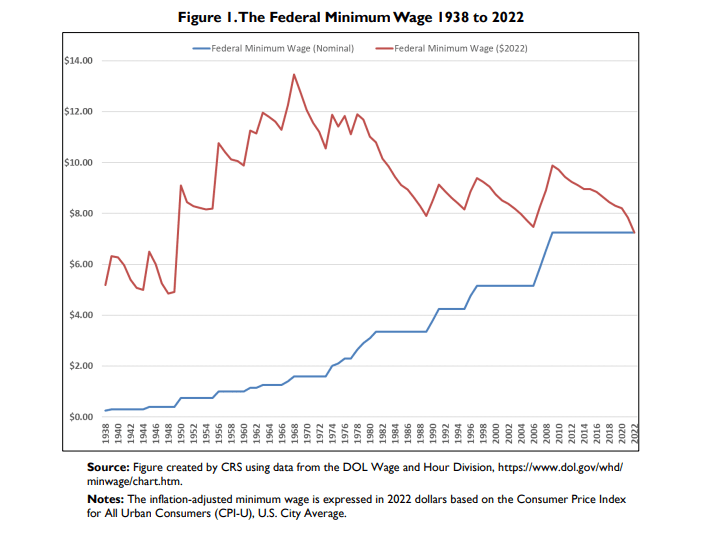
State Minimum Wage Laws
Many states have their own minimum wage laws, and when this happens, employers must pay workers the higher wage. As of last year, 30 states had set minimum wages higher than the federal amount.[18]Bradley, David H.; Overbay, Abigail R. State Minimum Wages: An Overview. This document can be found in HeinOnline’s U.S. Congressional Documents and Labor and Employment: The American Worker databases. Washington, D.C. currently has the highest minimum wage, at $17.00 per hour. Additionally, some cities and counties offer minimum wages that are higher than the state level. For example, San Francisco’s minimum wage is $18.08, while California’s is $15.50. Similarly, Santa Fe has a minimum wage of $14.03, compared to New Mexico’s $12.00. New York City pays $15.00 per hour, while New York State pays $14.20.
On the contrary, 25 states have passed preemption laws, which prevent local governments from setting their own minimum wage amounts. And 17 states have passed minimum wage laws that ensure that wages are indexed to inflation.[19]Effects on Employment & Family Income of Increasing the Federal Minimum Wage (Washington, D.C.: Congressional Budget Office., 2019). This document can be found in HeinOnline’s U.S. Congressional Documents and Labor and … Continue reading

Currently, the following states and U.S. territories have minimum wage set at the federal level of $7.25 per hour:
- Northern Mariana Islands
- Georgia
- Iowa
- Idaho
- Indiana
- Kansas
- Kentucky
- North Carolina
- North Dakota
- New Hampshire
- Oklahoma
- Pennsylvania
- Texas
- Utah
- Wisconsin
- Wyoming
Minimum wage is not required at the state level in the following states:
- Alabama
- Louisiana
- Mississippi
- South Carolina
- Tennessee
You can learn more about state minimum wages and compare and contrast state minimum wage laws with HeinOnline’s National Survey of State Laws database—learn more below!
Wages Today
Although the federal minimum wage has been raised more than 22 times since 1938, it has not increased since 2009. Adjusted for inflation, the $7.25 an hour that was passed in 2009 currently has an equivalent buying power of $5.01 today. There have been many conversations about raising the federal minimum wage to $15 which have not come to fruition, although some states have raised their own minimum wage laws to that amount. However, in 2022, as part of the Inflation Reduction Act, President Biden passed an executive order[20]Administration of Joseph R. Biden, Jr., 2021 Executive Order 14026-Increasing the Minimum Wage for Federal Contractors , Daily Comp. Pres. Docs. 1 (2021). This executive order can be found in HeinOnline’s Federal Register Library. which raised the minimum wage to $15 an hour for all federal contractors.

Work Your Way into Labor Law with a 10% Discount
Immerse yourself in the rich history and current landscape of America’s workforce with HeinOnline’s Labor and Employment: The American Worker. This comprehensive database combines legislative histories, Supreme Court case briefs, accounts of historical labor riots, current reports on working conditions, and so much more. Additionally, this collection features a new interactive timeline, which researchers can use to research labor efforts to organize from 1842 up to the current decline—and rise—of unions in America.
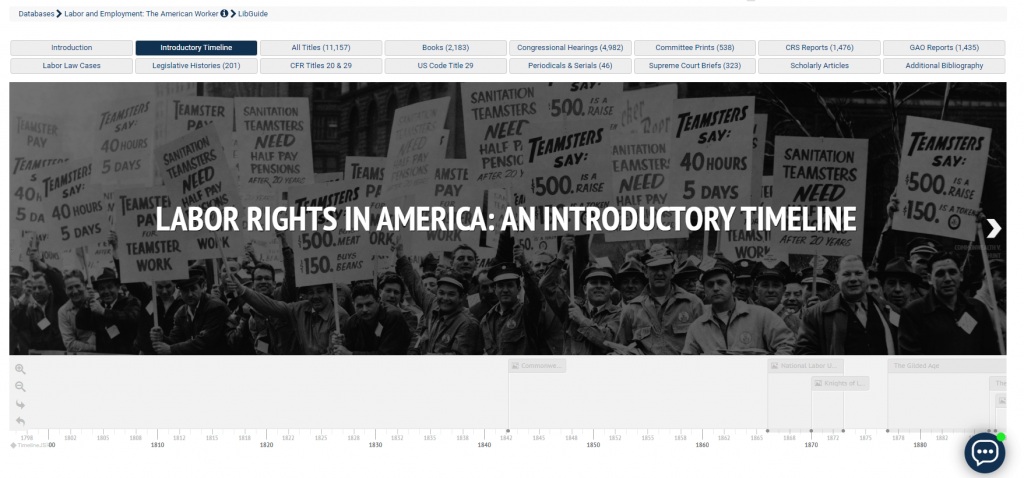
Pricing for this database starts as low as a one-time payment of $395.00*. And in honor of Labor Day, HeinOnline is offering this collection of nearly 11,000 titles for a 10% discount! But hurry, because this offer expires on October 6, 2023.
*Pricing varies between $395-$595 for HeinOnline Core subscribers. If you do not subscribe to a HeinOnline Core package, a custom quote will be provided
Other Valuable Resources
Additionally, HeinOnline offers an online version of Richard Leiter’s National Survey of State Laws, which allows users to make state-by-state comparisons of current state laws, including minimum wage laws. The interactive chart within the database allows users to select a category or topic, and the State Filter option limits the chart to the laws of the selected states.
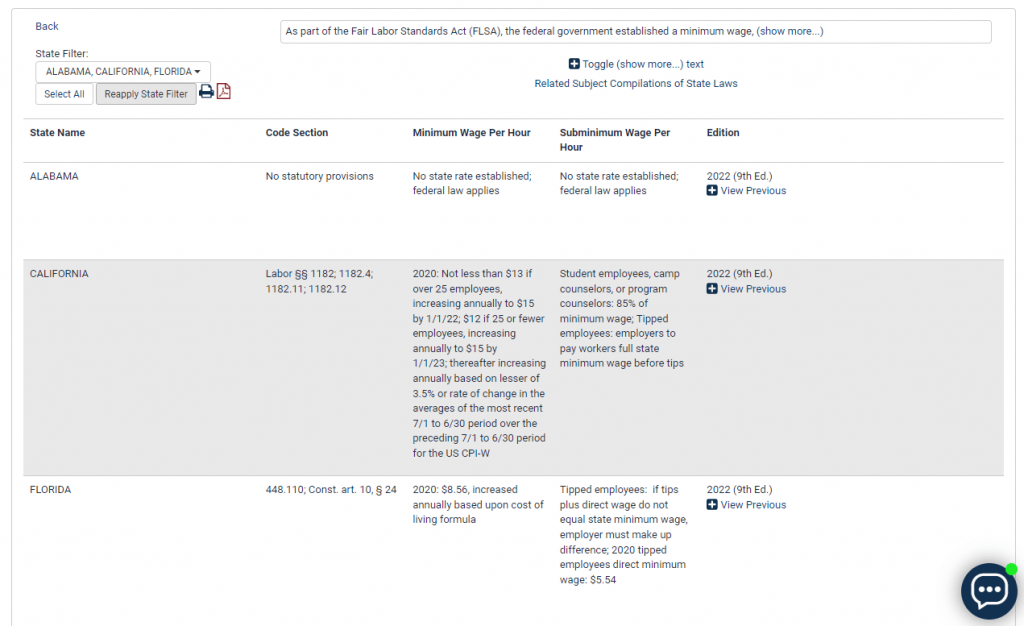
The database is regularly updated to stay current on newly passed laws, and it contains 50+ chapters on hot-button topics such as abortion, capital punishment, gun control, marijuana, right to die, and more.
Pricing for NSSL:
- 1 copy of the 9th edition and online access for one location: $265.00
- Additional print copies: $105.00 each
- 1 print copy and online access for multiple locations: $335.00
HeinOnline Sources[+]
| ↑1 | Edgar S.; Guild Furniss, Lawrence R. Labor Problems: A Book of Materials for Their Study (1925). This book can be found in HeinOnline’s Legal Classics and Labor and Employment: The American Worker databases. |
|---|---|
| ↑2 | By the Sweat and Toil of Children: A Report to the Committees on Appropriations, United States Congress (1997). This document can be found in HeinOnline’s Legal Classics and Labor and Employment: The American Worker databases. |
| ↑3 | ‘Massachusetts – General Court, Acts and Resolves 771. This Law can be found in HeinOnline’s Session Laws Library. |
| ↑4 | Michael Schuman, History of Child Labor in the United States – Part 2: The Reform Movement, 140 MONTHLY LAB. REV. 1 (2017). This article can be found in HeinOnline’s Law Journal Library and Labor and Employment: The American Worker databases. |
| ↑5 | Lochner v. New York, 198 U.S. 45, 76 (1905). This case can be found in HeinOnline’s U.S. Supreme Court Library and Labor and Employment: The American Worker databases. |
| ↑6 | Adkins et al., Constituting the Minimum Wage Board of the District of Columbia, v. Children’s Hospital of the District of Columbia – Same v. Lyons, 261 U.S. 525, 570 (1923). This case can be found in HeinOnline’s U.S. Supreme Court Library and Labor and Employment: The American Worker databases. |
| ↑7 | To encourage national industrial recovery, to foster fair competition, and to provide for the construction of certain useful public works, and for other purposes., Public Law 73-67 / Chapter 90, 73 Congress. 48 Stat. 195 (1928-1934) (1933). This act can be found in HeinOnline’s U.S. Statutes at Large database. |
| ↑8 | A. L. A. Schechter Poultry Corp. et al. v. United States, 295 U.S. 495, 554 (1935). This case can be found in HeinOnline’s U.S. Supreme Court Library and Labor and Employment: The American Worker databases. |
| ↑9 | West Coast Hotel Co. v. Parrish et al, 300 U.S. 379, 413 (1937). This case can be found in HeinOnline’s U.S. Supreme Court Library and Labor and Employment: The American Worker databases. |
| ↑10 | To provide for the establishment of fair labor standards in employments in and affecting interstate commerce, and for other purposes., Public Law 75-718 / Chapter 676, 75 Congress. 52 Stat. 1060 (1938). This act can be found in HeinOnline’s U.S. Statutes at Large database. |
| ↑11 | United States v. Darby, 312 U.S. 100, 125 (1941). This case can be found in HeinOnline’s U.S. Supreme Court Library and Labor and Employment: The American Worker databases. |
| ↑12 | To amend the Fair Labor Standards Act of 1938, as amended, to provide coverage for employees of large enterprises engaged in retail trade or service and of other employers engaged in commerce or in the production of goods for commerce, to increase the minimum wage under the Act to $1.25 an hour, and for other purposes., Public Law 87-30, 87 Congress. 75 Stat. 65 (1961). This act can be found in HeinOnline’s U.S. Statutes at Large database. |
| ↑13 | To amend the Fair Labor Standards Act of 1938 to extend its protection to additional employees, to raise the minimum wage, and for other purposes., Public Law 89-601, 89 Congress. 80 Stat. 830 (1966). This act can be found in HeinOnline’s U.S. Statutes at Large database. |
| ↑14 | To amend the Fair Labor Standards Act of 1938 to increase the minimum wage, and for other purposes., Public Law 101-157, 101 Congress. 103 Stat. 938 (1989). This act can be found in HeinOnline’s U.S. Statutes at Large database. |
| ↑15 | To prohibit discrimination on account of sex in the payment of wages by employers engaged in commerce or in the production of goods for commerce., Public Law 88-38, 88 Congress. 77 Stat. 56 (1963). This act can be found in HeinOnline’s U.S. Statutes at Large database. |
| ↑16 | Mayer, Gerald. Federal Minimum Wage: The Issue of Indexation. This document can be found in HeinOnline’s U.S. Congressional Documents and Labor and Employment: The American Worker databases. |
| ↑17 | U.S. Troop Readiness, Veterans’ Care, Katrina Recovery, and Iraq Accountability Appropriations Act, 2007., Public Law 110-28, 110 Congress. 121 Stat. 112 (2007). This act can be found in HeinOnline’s U.S. Statutes at Large database. |
| ↑18 | Bradley, David H.; Overbay, Abigail R. State Minimum Wages: An Overview. This document can be found in HeinOnline’s U.S. Congressional Documents and Labor and Employment: The American Worker databases. |
| ↑19 | Effects on Employment & Family Income of Increasing the Federal Minimum Wage (Washington, D.C.: Congressional Budget Office., 2019). This document can be found in HeinOnline’s U.S. Congressional Documents and Labor and Employment: The American Worker databases. |
| ↑20 | Administration of Joseph R. Biden, Jr., 2021 Executive Order 14026-Increasing the Minimum Wage for Federal Contractors , Daily Comp. Pres. Docs. 1 (2021). This executive order can be found in HeinOnline’s Federal Register Library. |



